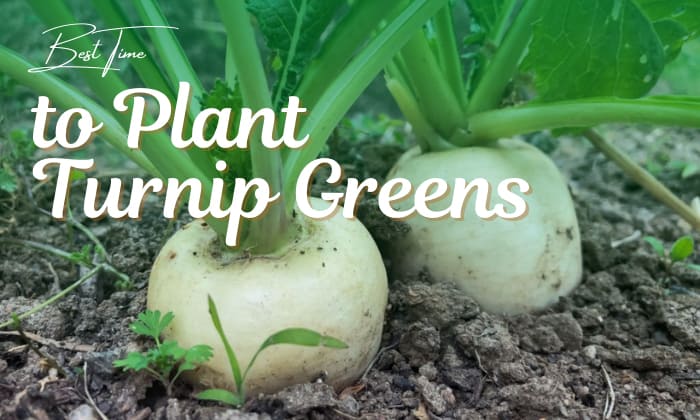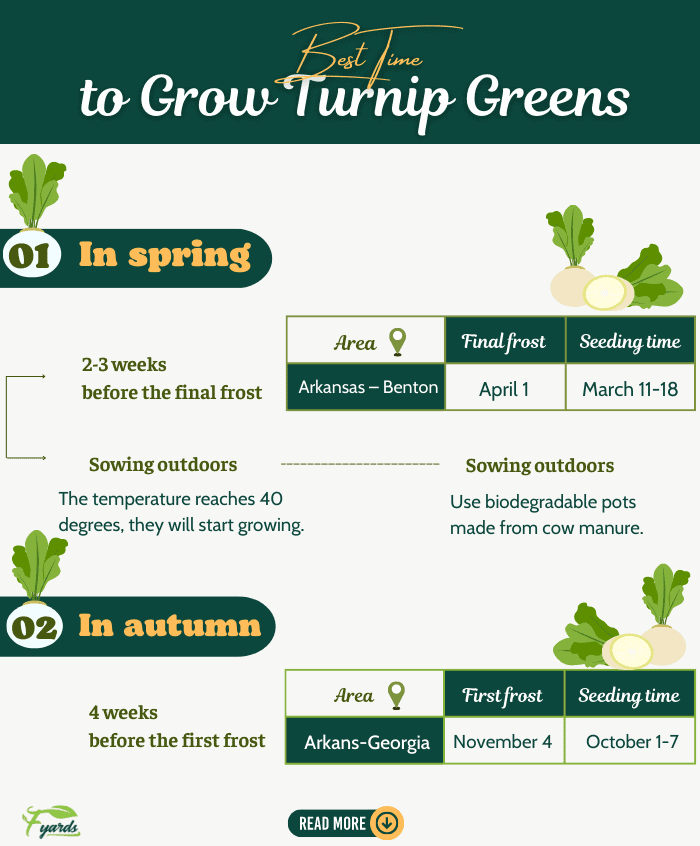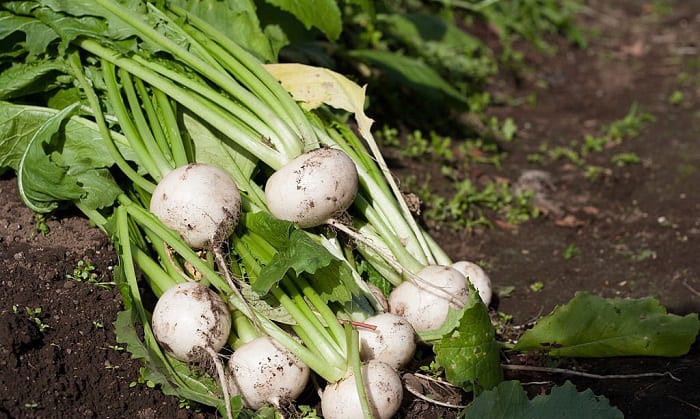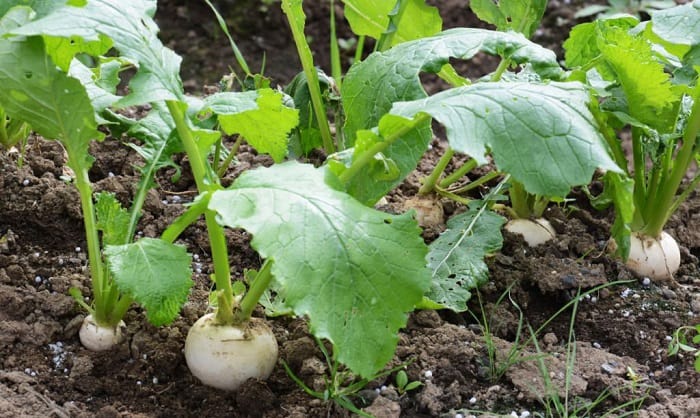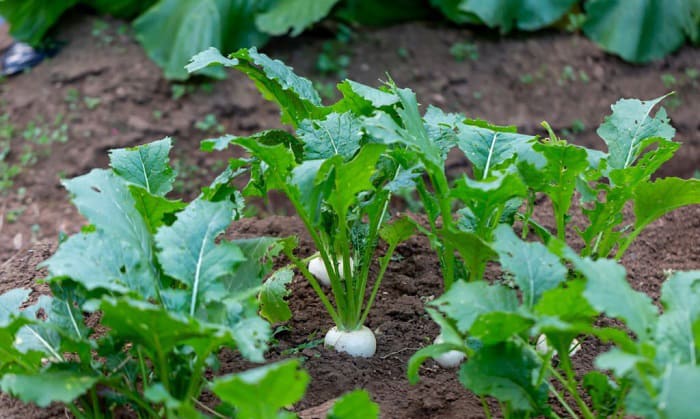Many people tend to throw turnip leaves away and eat only their roots. However, these greens are not at all useless. They make for lovely additions to salads, soups, and stir-fries and contain many nutrients, such as vitamins A, C, and K.
It’s due to these benefits that many wonder when to plant turnip greens.
If you have the same query, know that the turnips growing season is ideally in the fall, with spring being the second-best period. Generally, the time for planting is December to May, depending on how late your last frost is. During the fall months, growing turnip greens is possible from August to February.
Table of Contents
When to Grow Turnip Greens
First, it’s important to establish that transplanting can disturb the roots of turnip greens. As a result, it’s better to grow these crops from seeds rather than nursery plants.
With that in mind, follow the guidelines below to determine the best time to plant turnip greens:
- In spring, sow seeds in a container or in-ground two to three weeks before the final frost.
Suppose you’re living in Arkansas – Benton, to be exact – your last frost will fall on April 1, making March 11 to 18 the ideal seeding time.
However, the frost rule is not the only thing to keep in mind. Remember to sow turnips outdoors when the ground is workable If the soil is not tillable yet, wait until the weather is warmer.
There’s no need to worry if early seeding outside doesn’t result in immediate sprouting; as soon as the temperature reaches 40 degrees, your plant will start growing.
However, if you must sow seeds indoors, use biodegradable pots made from cow manure to minimize transplant shock.
- As for planting turnip greens in autumn, I recommend growing them four weeks before the first frost.
This season is suitable for many states in the south, such as in Alabama, whose optimal gardening time is mid-September, or in Tennessee, where turnips best grow in August and September.
To give you another example, Athens in Georgia has its first frost on November 4. Therefore, people here should grow turnips in October, on the 7th day of the month at the latest.
It’s vital to follow the four-week rule, since one month is often sufficient for turnip greens to mature fully. After that length of time, you can subject the plants to a light frost for sweeter flavors, then immediately harvest them without worrying about disrupted growth.
If you plant them too late, turnips will cease developing when the weather is colder than 10 degrees Fahrenheit.
That said, for areas with rare or non-existent freeze, such as south Louisiana, you may be able to grow turnips throughout winter. In fact, people in this state often plant them from August to February.
How to Plant Turnip Greens
Turnip greens grow best in a soil pH of 6.0 to 7.5. Before planting, lower the soil pH with sulfur or compost if necessary. Alternatively, raise the alkalinity level by incorporating limestone or wood ash into the ground.
Whatever amendment you use, apply it at least six months prior to gardening. Otherwise, the soil won’t adjust in time for your turnip season.
Then, on the seeding date, rake the ground at a depth of 10 inches and apply fertilizer to it. Follow the recommendations of your soil test, which will state what nutrients you should add to the garden bed. Note that nitrogen-rich formulas should be avoided.
Afterward, sow turnip seeds two inches apart at a depth of 0.5 inch, but not before watering the planting site. As the seeds develop, you’ll need to cut the young plants to prevent overcrowding. In fact, do so one week after sprouting occurs. Make sure there are three inches of space between two plants, but go for six inches to be safe.
At the same time, give turnips a temperature of 40 to 60℉ for ideal growth. Though they may germinate in hotter weather, extended heat periods of 105 degrees will affect plant health.
Most importantly, water your turnip seedling with an inch of moisture per week at regular intervals and mulch the soil when your greens are six inches tall. Your crop rows should also be 18 inches apart and far away from other root veggies.
Harvesting Turnip Greens
To harvest turnip greens, cut the outer leaves near the bottom of the plant when they’re about four inches long. Afterward, let the rest of the turnip grow normally and produce new foliage in about two weeks. If you do so, it’s possible to enjoy multiple harvests while turnips are in season.
Alternatively, wait until the whole crop matures before pulling it. Only do so when the soil is dry so that you can easily loosen the earth around the plant base. This will make it easier to pull off turnips without breaking the roots.
Whatever method you choose, pick turnips in the morning if possible and eat them immediately.
FAQs
Can I pick turnip greens and still harvest the roots later?
Yes. You can cut the leaves before collecting the roots. However, remember to leave some foliage in place so that the roots don’t grow too small. Moreover, cut the outer leaves only, not the inner ones.
How long does it take turnip greens to grow?
Turnip greens will finish growing in one to two months, depending on the variety you choose. Just add the maturation period of the plant to your seeding date to determine harvest time.
For instance, if you start gardening in August or October, which is often the case in Mississippi, your turnips will be collectible in September or November.
Conclusion
Honestly, determining when to plant turnip greens is not that difficult.
Just remember this advice while you garden: Grow your turnips under cool weather so that they don’t die from extreme freeze or become bitter under excess heat.
As long as you keep this guideline in mind, cultivating turnip greens should be easy-peasy.
Read next:

Hi, I am William – Floridayards’ digital content creator. My job is to find answers to all your concerns with thorough research and our team’s expert advice. I will also bring you honest reviews on the best products and equipment for raising your beautiful garden. Please look forward to our work!


